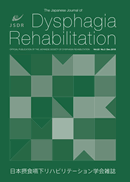Volume 6, Issue 2
The Japanese Journal of Dysphagia Rehabilitation
Displaying 1-19 of 19 articles from this issue
- |<
- <
- 1
- >
- >|
Review Article
-
2002Volume 6Issue 2 Pages 117-123
Published: December 30, 2002
Released on J-STAGE: August 20, 2020
Download PDF (2839K) -
2002Volume 6Issue 2 Pages 124-130
Published: December 30, 2002
Released on J-STAGE: August 20, 2020
Download PDF (3126K) -
2002Volume 6Issue 2 Pages 131-139
Published: December 30, 2002
Released on J-STAGE: August 20, 2020
Download PDF (4164K) -
2002Volume 6Issue 2 Pages 140-147
Published: December 30, 2002
Released on J-STAGE: August 20, 2020
Download PDF (4144K) -
2002Volume 6Issue 2 Pages 148-150
Published: December 30, 2002
Released on J-STAGE: August 20, 2020
Download PDF (1378K)
Original Paper
-
2002Volume 6Issue 2 Pages 151-157
Published: December 30, 2002
Released on J-STAGE: August 20, 2020
Download PDF (2969K) -
2002Volume 6Issue 2 Pages 158-166
Published: December 30, 2002
Released on J-STAGE: August 20, 2020
Download PDF (3715K) -
2002Volume 6Issue 2 Pages 167-178
Published: December 30, 2002
Released on J-STAGE: August 20, 2020
Download PDF (5213K) -
2002Volume 6Issue 2 Pages 179-186
Published: December 30, 2002
Released on J-STAGE: August 20, 2020
Download PDF (3824K) -
2002Volume 6Issue 2 Pages 187-195
Published: December 30, 2002
Released on J-STAGE: August 20, 2020
Download PDF (3909K) -
2002Volume 6Issue 2 Pages 196-206
Published: December 30, 2002
Released on J-STAGE: August 20, 2020
Download PDF (4862K) -
2002Volume 6Issue 2 Pages 207-217
Published: December 30, 2002
Released on J-STAGE: August 20, 2020
Download PDF (5281K)
Clinical Report
-
2002Volume 6Issue 2 Pages 218-224
Published: December 30, 2002
Released on J-STAGE: August 20, 2020
Download PDF (3376K) -
2002Volume 6Issue 2 Pages 225-228
Published: December 30, 2002
Released on J-STAGE: August 20, 2020
Download PDF (1934K) -
2002Volume 6Issue 2 Pages 229-235
Published: December 30, 2002
Released on J-STAGE: August 20, 2020
Download PDF (3079K)
Research Report
-
2002Volume 6Issue 2 Pages 236-241
Published: December 30, 2002
Released on J-STAGE: August 20, 2020
Download PDF (2375K) -
2002Volume 6Issue 2 Pages 242-246
Published: December 30, 2002
Released on J-STAGE: August 20, 2020
Download PDF (2205K) -
2002Volume 6Issue 2 Pages 247-251
Published: December 30, 2002
Released on J-STAGE: August 20, 2020
Download PDF (2035K) -
2002Volume 6Issue 2 Pages 252-258
Published: December 30, 2002
Released on J-STAGE: August 20, 2020
Download PDF (2796K)
- |<
- <
- 1
- >
- >|
